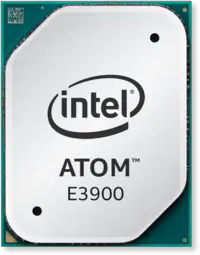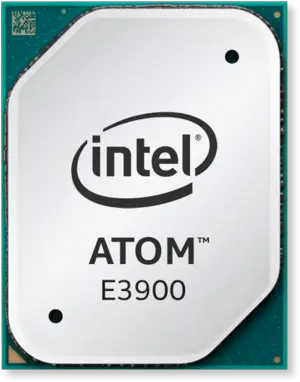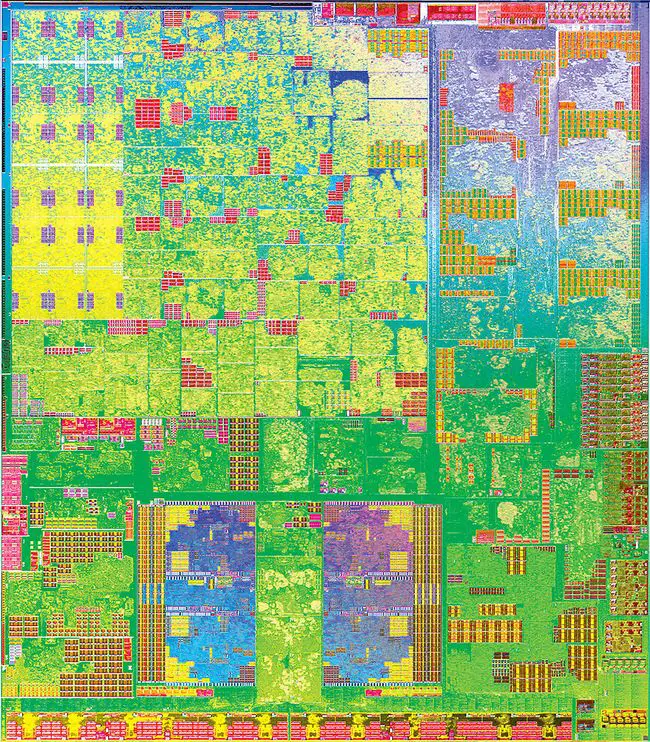From WikiChip
Difference between revisions of "intel/atom x7/x7-e3950"
m (Bot: moving all {{mpu}} to {{chip}}) |
|||
| (14 intermediate revisions by 2 users not shown) | |||
| Line 1: | Line 1: | ||
{{intel title|Atom x7-E3950}} | {{intel title|Atom x7-E3950}} | ||
| − | {{ | + | {{chip |
| name = Intel Atom x7-E3950 | | name = Intel Atom x7-E3950 | ||
| − | | no image = | + | | no image = |
| − | | image = | + | | image = Atom E3900 SoC Front.png |
| image size = | | image size = | ||
| caption = | | caption = | ||
| + | | designer = Intel | ||
| manufacturer = Intel | | manufacturer = Intel | ||
| model number = x7-E3950 | | model number = x7-E3950 | ||
| Line 42: | Line 43: | ||
| thread count = 4 | | thread count = 4 | ||
| max cpus = 1 | | max cpus = 1 | ||
| − | | max memory = | + | | max memory = 8 GiB |
| max memory addr = | | max memory addr = | ||
| − | + | ||
| power = | | power = | ||
| − | | sdp = | + | | sdp = |
| − | | tdp = | + | | tdp = 12 W |
| ctdp down = | | ctdp down = | ||
| ctdp down frequency = | | ctdp down frequency = | ||
| Line 70: | Line 71: | ||
| socket 0 type = BGA | | socket 0 type = BGA | ||
}} | }} | ||
| − | The '''Atom x7-E3950''' is a {{arch|64}} quad-core | + | The '''Atom x7-E3950''' is a {{arch|64}} [[quad-core]] [[x86]] system on a chip set to be introduced by [[Intel]] in early 2017. This ultra-low power MPU, which was specifically designed for the [[internet of things|IoTs]], operates at 1.6 GHz and has a TDP of 12 W. This chip is based on the {{intel|Goldmont|l=arch}}, manufactured on Intel's enhanced [[14 nm process]]. |
| − | |||
| − | |||
== Cache == | == Cache == | ||
{{main|intel/microarchitectures/goldmont#Memory_Hierarchy|l1=Goldmont § Cache}} | {{main|intel/microarchitectures/goldmont#Memory_Hierarchy|l1=Goldmont § Cache}} | ||
| Line 95: | Line 94: | ||
== Memory controller == | == Memory controller == | ||
{{integrated memory controller | {{integrated memory controller | ||
| − | | type = | + | | type = DDR3L-1866 |
| − | | type 2 | + | | type 2 = LPDDR4-2400 |
| − | |||
| − | |||
| − | |||
| − | |||
| − | |||
| − | |||
| − | |||
| controllers = 1 | | controllers = 1 | ||
| − | | channels = | + | | channels = 4 |
| ecc support = Yes | | ecc support = Yes | ||
| − | | bandwidth schan = | + | | max bandwidth = 35.76 GiB/s |
| − | | bandwidth dchan = | + | | bandwidth schan = 17.88 GiB/s |
| − | | max memory = 8 | + | | bandwidth dchan = 35.76 GiB/s |
| + | | max memory = 8 GiB | ||
| + | | pae = 40 bit | ||
}} | }} | ||
== Graphics == | == Graphics == | ||
{{integrated graphic | {{integrated graphic | ||
| − | | gpu = HD Graphics | + | | gpu = HD Graphics 505 |
| − | | device id = | + | | device id = 0x5A84 |
| − | | execution units = | + | | execution units = 18 |
| displays = 3 | | displays = 3 | ||
| − | | frequency = | + | | frequency = 500 MHz |
| − | | max frequency = | + | | max frequency = 650 MHz |
| − | | max memory = | + | | max memory = 2 GiB |
| output crt = | | output crt = | ||
| Line 155: | Line 149: | ||
| max res vga freq = | | max res vga freq = | ||
| − | | intel quick sync = | + | | intel quick sync = Yes |
| intel intru 3d = | | intel intru 3d = | ||
| intel insider = | | intel insider = | ||
| intel widi = | | intel widi = | ||
| intel fdi = | | intel fdi = | ||
| − | | intel clear video = | + | | intel clear video = Yes |
}} | }} | ||
| Line 167: | Line 161: | ||
== Expansions == | == Expansions == | ||
| − | {{ | + | {{expansions |
| pcie revision = 2.0 | | pcie revision = 2.0 | ||
| pcie lanes = 4 | | pcie lanes = 4 | ||
| Line 184: | Line 178: | ||
== Features == | == Features == | ||
| − | {{ | + | {{x86 features |
| em64t = Yes | | em64t = Yes | ||
| nx = Yes | | nx = Yes | ||
| − | | txt = | + | | txt = |
| tsx = | | tsx = | ||
| vpro = | | vpro = | ||
| Line 219: | Line 213: | ||
| os guard = | | os guard = | ||
| intel at = | | intel at = | ||
| + | | intel ipt = Yes | ||
}} | }} | ||
| + | |||
| + | == Die Shot == | ||
| + | Intel {{intel|Goldmont|l=arch}}-based {{intel|Atom}} E3900 SoC series die shot: | ||
| + | :[[File:atom e3900 die shot.jpg|650px]] | ||
== Documents == | == Documents == | ||
* [[:File:atom-e3900-fact-sheet.pdf|Intel Atom Processor E3900 Series Fact Sheet]] | * [[:File:atom-e3900-fact-sheet.pdf|Intel Atom Processor E3900 Series Fact Sheet]] | ||
Latest revision as of 15:15, 13 December 2017
| Edit Values | |
| Intel Atom x7-E3950 | |
 | |
| General Info | |
| Designer | Intel |
| Manufacturer | Intel |
| Model Number | x7-E3950 |
| Market | Embedded |
| Introduction | October 26, 2016 (announced) 2017 (launched) |
| Shop | Amazon |
| General Specs | |
| Family | Atom x7 |
| Series | E3900 |
| Locked | Yes |
| Frequency | 1600 MHz |
| Turbo Frequency | Yes |
| Turbo Frequency | 2000 MHz (1 core) |
| Microarchitecture | |
| Microarchitecture | Goldmont |
| Platform | Apollo Lake |
| Core Name | Apollo Lake |
| Process | 14 nm |
| Technology | CMOS |
| Word Size | 64 bit |
| Cores | 4 |
| Threads | 4 |
| Max Memory | 8 GiB |
| Multiprocessing | |
| Max SMP | 1-Way (Uniprocessor) |
| Electrical | |
| TDP | 12 W |
| Tjunction | -40 °C – 110 °C |
The Atom x7-E3950 is a 64-bit quad-core x86 system on a chip set to be introduced by Intel in early 2017. This ultra-low power MPU, which was specifically designed for the IoTs, operates at 1.6 GHz and has a TDP of 12 W. This chip is based on the Goldmont, manufactured on Intel's enhanced 14 nm process.
Cache[edit]
- Main article: Goldmont § Cache
| Cache Info [Edit Values] | ||
| L1I$ | 64 KiB 65,536 B 0.0625 MiB |
2x32 KiB 8-way set associative (per core) |
| L1D$ | 48 KiB 49,152 B 0.0469 MiB |
2x24 KiB 6-way set associative (per core) |
| L2$ | 2 MiB 2,048 KiB 2,097,152 B 0.00195 GiB |
2x1 MiB 16-way set associative (per 2 cores) |
| L3$ | 0 KiB 0 MiB 0 B 0 GiB |
No L3$ |
Memory controller[edit]
| Integrated Memory Controller | |
| Type | DDR3L-1866, LPDDR4-2400 |
| Controllers | 1 |
| Channels | 4 |
| ECC Support | Yes |
| Max bandwidth | 35.76 GiB/s |
| Bandwidth (single) | 17.88 GiB/s |
| Bandwidth (dual) | 35.76 GiB/s |
| Max memory | 8 GiB |
| Physical Address Extensions | 40 bit |
Graphics[edit]
| Integrated Graphic Information | |
| GPU | HD Graphics 505 |
| Device ID | 0x5A84 |
| Execution Units | 18 |
| Displays | 3 |
| Frequency | 500 MHz 0.5 GHz
500,000 KHz |
| Max frequency | 650 MHz 0.65 GHz
650,000 KHz |
| Max memory | 2 GiB 2,048 MiB
2,097,152 KiB 2,147,483,648 B |
| Output | DisplayPort, Embedded DisplayPort, HDMI, DSI |
| DirectX | 12 |
| OpenGL | 4.3 |
| OpenCL | 1.2 |
| OpenGL ES | 3.0 |
| HDMI | 1.4b |
| DP | 1.2 |
| eDP | 1.3 |
| Max HDMI Res | 3840x2160 @30 Hz |
| Max DSI Res | 2560x1600 @60 Hz |
| Max DP Res | 4096x2160 @60 Hz |
| Max eDP Res | 3840x2160 @60 Hz |
| Intel Quick Sync Video | |
| Intel Clear Video | |
- Video decode hardware acceleration including support for HEVC (H.265), H.264, MVC, VP8, VP9, MPEG2, VC-1, WMV9, JPEG/MJPEG.
- Video encode hardware acceleration including support for HEVC (H.265), H.264, MVC, VP8, VP9, JPEG/MJPEG.
Expansions[edit]
|
Expansion Options
|
||||||||||||||||||||||
|
||||||||||||||||||||||
Features[edit]
[Edit/Modify Supported Features]
|
Supported x86 Extensions & Processor Features
|
||||||||||||||||||||
|
||||||||||||||||||||
Die Shot[edit]
Intel Goldmont-based Atom E3900 SoC series die shot:
Documents[edit]
Facts about "Atom x7-E3950 - Intel"
| Has subobject "Has subobject" is a predefined property representing a container construct and is provided by Semantic MediaWiki. | Atom x7-E3950 - Intel#io + |
| base frequency | 1,600 MHz (1.6 GHz, 1,600,000 kHz) + |
| core count | 4 + |
| core name | Apollo Lake + |
| designer | Intel + |
| device id | 0x5A84 + |
| family | Atom x7 + |
| first announced | October 26, 2016 + |
| first launched | 2017 + |
| full page name | intel/atom x7/x7-e3950 + |
| has extended page tables support | true + |
| has feature | integrated gpu +, Advanced Encryption Standard Instruction Set Extension +, Burst Performance Technology +, Enhanced SpeedStep Technology + and Extended Page Tables + |
| has intel burst performance technology | true + |
| has intel enhanced speedstep technology | true + |
| has locked clock multiplier | true + |
| has second level address translation support | true + |
| has x86 advanced encryption standard instruction set extension | true + |
| instance of | microprocessor + |
| integrated gpu | HD Graphics 505 + |
| integrated gpu base frequency | 500 MHz (0.5 GHz, 500,000 KHz) + |
| integrated gpu max frequency | 650 MHz (0.65 GHz, 650,000 KHz) + |
| integrated gpu max memory | 2,048 MiB (2,097,152 KiB, 2,147,483,648 B, 2 GiB) + |
| l1d$ description | 6-way set associative + |
| l1d$ size | 48 KiB (49,152 B, 0.0469 MiB) + |
| l1i$ description | 8-way set associative + |
| l1i$ size | 64 KiB (65,536 B, 0.0625 MiB) + |
| l2$ description | 16-way set associative + |
| l2$ size | 2 MiB (2,048 KiB, 2,097,152 B, 0.00195 GiB) + |
| l3$ description | No L3$ + |
| l3$ size | 0 MiB (0 KiB, 0 B, 0 GiB) + |
| ldate | 2017 + |
| main image |  + + |
| manufacturer | Intel + |
| market segment | Embedded + |
| max cpu count | 1 + |
| max junction temperature | 383.15 K (110 °C, 230 °F, 689.67 °R) + |
| max memory | 8,192 MiB (8,388,608 KiB, 8,589,934,592 B, 8 GiB, 0.00781 TiB) + |
| max pcie lanes | 4 + |
| microarchitecture | Goldmont + |
| min junction temperature | 233.15 K (-40 °C, -40 °F, 419.67 °R) + |
| model number | x7-E3950 + |
| name | Intel Atom x7-E3950 + |
| platform | Apollo Lake + |
| process | 14 nm (0.014 μm, 1.4e-5 mm) + |
| series | E3900 + |
| smp max ways | 1 + |
| tdp | 12 W (12,000 mW, 0.0161 hp, 0.012 kW) + |
| technology | CMOS + |
| thread count | 4 + |
| turbo frequency (1 core) | 2,000 MHz (2 GHz, 2,000,000 kHz) + |
| word size | 64 bit (8 octets, 16 nibbles) + |
